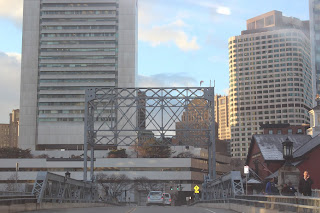Boston is a big city. Much bigger than I imagined it would be. There are so many neighborhoods to visit and I tried my very best to cover them all. But really how much can one do in four days? The answer is enough, but enough to satisfy me? Probably not.
I am learning to accept that I get to see what I get to see and that I will always have to revisit places I enjoy in order to see everything. Admittingly, I am not great at that though.
In order to manage my anxiety about such issues I am vigilant at keeping updated itineraries for the next time I visit, well anywhere. This way I am sure not to miss anything, ever.
The list for Boston is long. Longer than I’d like. Although I do feel like I made a great big dent on this first and only trip to Boston I’ve made so far.
- Lewis-Harriet Hayden House/ Craft House - The historic home of William and Ellen Craft who escaped slavery by pretending to be a white man and his black servant as I learned when I took an Underground Railroad walking tour in NYC (http://bit.ly/2ACCF2G).
- Freedom Trail - A line of red paint marks this two and a half miles of sixteen historic sites surrounding the American Revolution. I would love to see them all especially these.
- Boston Commons - It is the oldest park in the country and the site where Ralph Waldo Emerson herded his mother's cows. The park was purchased in 1634. Be sure to see the twenty-two foot Brewer Fountain featuring mythological creatures.
- Granary Burying Ground - Established in 1660, yet not even close to the oldest in Boston but a popular favorite for the designs and having interned: Paul Revere, Samuel Adams, John Hancock, Benjamin Franklin's parents, as well as Elizabeth Foster Goose a.k.a. Mother Goose.
- King’s Chapel Burying Ground - This is the oldest grave yard in Boston dating back to 1630 when Europeans first settled the area. Mary Chilton, the first women in America is buried here, as well as Elizabeth Pain who was the inspiration for the lead in the Scarlet Letter, Hester Prynne.
- Old South Meeting House - The site where the Boston Tea Party revolution began. Across the street at 1 Milk Street (formerly 17 Milk Street) was the site of Benjamin Franklin's birth in 1706.
- Boston Massacre Site - A circle of cobblestones honors the five men who were killed here by the British on March 5, 1770.
- Faneuil Hall - Known as the "Cradle of Liberty”, a place where the great orators of last centuries encouraged rebellion, reform, and protest. I described this location in depth in a prior post (http://bit.ly/2ACQSwB).
- Old Christ Church - The site of the Revere family’s pew and the first ever bust of George Washington. This is not to be confused wth Christ Church in Philadelphia (http://bit.ly/2AyJTDr).
- Paul Revere House - Home of the "Midnight Rider" himself where you can get a sense of his life as a craftsman, his family including the eight children he had with two different wives, as he worked to bring about American Revolution. The home was built in 1680.
- James Rego Square (Paul Revere Mall) - Check out the left side of this wall that’s marked with famous events throughout history and take picture of Paul Revere statute.
- Bunker Hill Monument - This infamous battle was actually took place on Breed Hill which you will be standing on here. There is a two hundred and twenty-one foot granite obelisk commemorating the attack on June 17, 1775. You can spent up to an hour here alone if you dare to climb the two hundred and ninety-four stairs to the top. There is a museum on the subject across the street.
- Skywalk Observatory at the Prudential Center - The highest vantage point in Boston where from the fiftieth floor you will have three hundred and sixty degree view. Inside there are numerous shops and pushcarts where you can spend some money.
- Quincy, Massachusetts - Not more than twenty or thirty miles from Boston is the site where two former presidents were born and raised; John Adams and his son John Quincy Adams. The hometown has numerous sites dedicated to the lives of these men and their families and I intend to see it all.
- Adams National Historic Park - Here you can visit the birthplace of both President Adams’, The Stone Library, Carriage House, a Summer White House (just like Teddy Roosevelt would have many years later), as well as thirteen acres of the landscape.
- United First Parish Church - After these historical sites I will come to this church to see the final resting place of both of these presidents and their wives.
I suppose this might be too much for one more trip, perhaps it will take at least two to get these items crossed off my to-do list.
No matter how long it takes it will get done and I will enjoy every moment of it.
For me and Boston, this is what remains.
For More Information:











Comments
Post a Comment